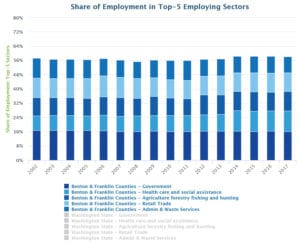
Home » Tri-City health care sector ranks as region’s second largest work force
Tri-City health care sector ranks as region’s second largest work force

January 14, 2019
By D. Patrick Jones
Despite recent challenges faced by local hospitals, health care here is acquiring all the features of a major medical center. Benton-Franklin Trends data makes this quite clear, tracking the share of the work force employed in the five highest-employing sectors. Health care is the second from the bottom in the graph. A visual inspection — or the pointer on your computer screen — will show a gain. In fact, the gain is the largest among the five.
In 15 years, the health care work force has climbed from fifth to second place in Benton and Franklin counties. Or, from 8.2 percent to 11.5 percent of the total work force. Among the top five employing sectors, only agriculture also has increased its share. In terms of jobs, health care has added 6,700 over the past 15 years, far more than the second- and third-fastest sectors of government and agriculture, respectively.

What forces have driven this? What parts of health care have climbed the most?
We first need to understand how economists track this sector. It is typically presented in four sub-sectors: ambulatory care, hospitals, nursing and residential care facilities, and social assistance organizations.
Ambulatory care is the largest, encompassing many “industries.” Among them are offices of physicians, dentists, chiropractors, various therapists, optometrists, mental health practitioners, kidney dialysis, outpatient mental health and substance abuse counselors, medical labs, home health services and blood banks.
Nursing and residential care facilities include nursing homes but also those for the developmentally disabled, centers addressing mental health and substance abuse, as well as continuing care and assisted living.
Social assistance organizations, strictly speaking, do not provide medical care. Yet, their work undergirds community health. Organizations counted in this sub-sector run the gamut, from child and youth services to community food and community housing services, and from vocational rehab to child care centers.
So which of these have grown the most in the greater Tri-Cities? Unfortunately, data don’t allow for a clear conclusion due to the necessary protection of sub-sectors with few players. Counts from ambulatory care, undoubtedly the largest, are thankfully available starting in 2005. Here the gain of employees has been about 2,500, or a percentage change of more than 75 percent. This growth has been more than twice the rate observed in Washington state.
For the other sub-sectors, we can only be guided by statewide numbers. If the experience in local health care has largely mirrored the state’s, headcounts in hospitals have grown but not as fast as those in social assistance organizations. Staff at nursing and residential care facilities have likely been the slowest to expand.
Why do we care? Certainly one reason is that good health is a paramount desire of everyone. A reason that economists will advance lies in wages: many, but hardly all, of the occupations found in these industries pay well. Benton-Franklin Trends data reveals that the sector overall ranked third among the top five for annual wages. In 2017, the annual wage amounted to slightly more than $46,000. (Online readers can easily simplify the graph by clicking off boxes of the legend.)
This average actually lies below the average wage for all employed in the two counties. Yet, the sector shows great variation. Staff at social assistance organizations were paid a meager $22,500 in 2017. Local workers in ambulatory care, on the other hand, earned about $52,500 in Benton County and $57,000 in Franklin County. If the local distribution among the sub-sectors follows the state pattern, the average paid to hospital staff was higher yet.
Another reason we should care lies with the local labor market: it is signaling that health care workers are in high demand. Thanks to a state survey compiled by the Department of Employment Security, we know the top 25 occupations in demand.
For the most recently available month, September, the ranking was telling. In Benton County, nurses posted the highest number of openings. Other health care professions followed: physicians and surgeons placed sixth and 10th; family practitioners 11th; medical service managers 14th. The list wasn’t quite as long in Franklin County, but nurses placed second among the postings there.
To return to an earlier question: what lies behind this growth in health care work force? An obvious cause rests in population growth. As Trends data reveals, the number in the two counties has shot up by a cumulative 42 percent since 2002, more than twice the rate of our robustly growing state and more than three times the rate of the U.S.
A second reason lies in rising incomes. Health follows wealth, or we prefer to “consume” more health care as incomes rise. As Trends data maps out, nominal incomes per person have increased, cumulatively, more than 50 percent over the same interval.
These two measures of the greater Tri-Cities show few signs of faltering. It seems safe to project that the health care work force will only continue to gain a larger share of all employment in the two counties.
Patrick Jones is executive director for Eastern Washington University’s Institute for Public Policy & Economic Analysis.
Local News Health Care
KEYWORDS january 2019





